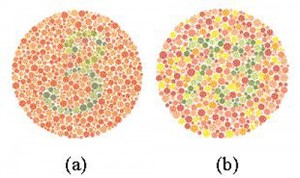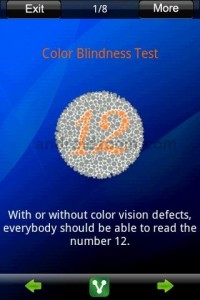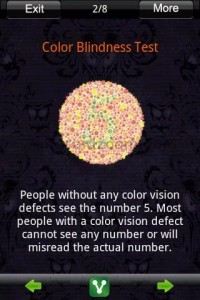Most of us take our eyesight for granted. For those of you who are blessed with problem-free eyesight, I congratulate you all. I have been having problems with my eyesight since my lower secondary school days.
I was diagnosed with myopia when I was in Form One at Kai Chung Middle School in Binatang (it was known by that name at that time). Though I had a pair of glasses prescribed after the diagnosis, I felt too shy to wear them in school as it made me look very nerdy. So I had to strain my eyes to see what the teachers were writing on the blackboard and this continued until one teacher noticed it and brought it to the attention of my parents when I was in Form Two. From then on, my parents made sure I wore my glasses to school. I guess my myopia is genetic as all my siblings suffer from myopia or nearsightedness.
And that is not the end of my eyesight problem. I am also colorblind. And my colorblindness has been a source of great frustration for me.
I think I first realized that I was colorblind when I was in Form one. One day my sister, who was in Form Five, brought home a book about colorblindness and there were simple tests in the book to determine whether one is colorblind. I took the test and it showed that I am red-green colorblind.
Color blindness or color vision deficiency is the inability to perceive differences between some colors that other people can distinguish. It is most often of genetic nature, but might also occur because of eye, nerve or brain damage or due to use of some chemical substances. 5%-8% of men and 0.5% of women are colorblind. A color-defective male always inherits his deficiency from his mother; the mother however is not colorblind.
In certain situations, color blind individuals have an advantage over those with normal color vision. There are some studies which conclude that color blind individuals are better at penetrating certain color camouflages. In World War II, colorblind men were sent on special missions, because their decreased ability to see green led to an increased ability to see through or detect camouflage.
If you see a three on the left and the number 73 on the right, you’re just fine. But if you see a five on the left, and just a bunch of spots on the right … you may be color blind.
Yup, I see a a five on the left and a bunch of spots on the right in the above test.
If you want more colorblind test, go here.
By the way, bulls are actually colorblind. It is the motion of a red cape which angers them, not the color itself.
I have been a stamp collector since young. In my stamp collection, I have many vintage stamps that could be worth quite a bit of money. With vintage stamps, I find it so hard to differentiate the colors. A certain green color vintage stamp may be worth a fortune whereas a reddish green one is worthless. But I just cannot tell the difference.
After I realized that I was colorblind, I shrugged it off as it did not seem to have any adverse effects on my life. But my colorblindness reared its ugly head during my upper secondary school days. During Chemistry classes in the lab, I was often stumped as I could not tell the color changes arising from chemical reactions. It was damn frustrating and it made me lost interest in Chemistry. And during my Senior Cambridge exams, I had someone assigned to sit next to me in the lab to tell me the color changes!
The same problem recurred in my Form Six at Kolej Tanjong Lobang (now known as Kolej Tun Datuk Patinggi Tuanku Haji Bujang) in Miri. In my lower six, my frustration made decide to drop Chemistry and to opt for Economics. So I started skipping my Chemistry classes but one day my General Mathematics teacher Mr Teo Ee Chin saw me walking in the campus during a Chemistry class and asked me how come I wasn’t attending my Chemistry class. I explained my situation to him, telling him about my decision to switch Chemistry for Economics. He advised me to carefully reconsider as Economics is an Arts subject and during HSC exams, the timetable for Economics exams might clash with my Science subject exams timetable. I had no choice but to go back to Chemistry classes but I must say I have always hated Chemistry!
I feel that our education system here in Malaysia is too rigid and non-flexible. On hindsight now, I wish I had been selected for Arts stream instead of Science stream during my Form Six. Because I have never liked Chemistry, Biology, Additional Maths and Physics, I was very de-motivated and ended up straying from my studies. The only class that I enjoyed was my General Paper class. To this day, I feel that it was a miracle that I managed to just pass my HSC.
My conviction that I would have done well if I had been in Arts stream in Form Six was confirmed when I went to Canada. I attended one semester of Grade 13 at Cosmopolitan College in Toronto where I opted for Arts subjects like Economics and English literature. That was the first time I ever took Arts subjects but I really excelled in them, topping my class in both Economics and English literature. With my results from that semester, I was able to gain admission to university.
I am sorry that I strayed from my topic for this post.
My eyesight problem took a turn for the worse when I was working in Brunei. One day I woke up to find that I seemed to have a slight vision distortion in my right eye. My boss in Brunei arranged for me to have a checkup with an eye specialist. It was diagnosed that a small blood vessel in my retina had burst. There was nothing that the specialist could do. I was told that it would heal and my vision would return to normal slowly. The distortion lasted for over a month. I had to exercise more caution when driving especially if I was overtaking. I had to lean to my right so that I could see better with my left eye.
About four years ago, I began suffering from stressed eyesight. It was so frustrating because I often found it difficult to do my work. My productivity nose-dived. When I had to rush reports on my computer, the frustration sometimes was so intense that I felt like screaming and punching the computer screen. Though I would have loved to continue working in Brunei, I tendered my resignation as I felt I had to be fair to my boss. In December 2007, I went to Kuala Lumpur to consult an eye specialist and decided to go for a cataract operation for both of my eyes. My Brunei boss very kindly footed the bill which came to RM6000. Thanks, Mr Ong! May God bless you for your kindness!
After returning to Miri, I rested for more than two years before I went back to the corporate world about ten months ago. My eyes are giving little problems now and I hope it will stay that way.
 CY@CY Says Welcome to my dreamscape. Where a Lim is also a Ling.
CY@CY Says Welcome to my dreamscape. Where a Lim is also a Ling.




Lim,
I am almost overwhelmed with the travails you have gone through because of your vision. If anything you have proven that the mind functions (extremely well) despite the handicaps of other organs.
I discovered your blog because I am trying to research a connection between color blindness and being FAR SIGHTED.
The connection is that our acuity is mostly determined by the interactive balance of the red (L) and green (M) photoreceptors in our eyes. An excess of red photoreceptors causes an imbalance and difficulty with near vision that might be connected to visual dyslexia. Color blindness should cause a similar dysfunction and imbalance and all 6 of the subjects I have contacted who are color blind are also far sighted.
The concept is based upon the discovery of Dr. Christopher Chase that some dyslexics have an excess of L-photoreceptors) and as a result have trouble focusing on close reading material.
His documentation is that “slow readers” (dyslexics) improve their reading skills and reading speed with the use of colored filters because of their “abnormal” ratio of L & M photoreceptors.
Below is the link to his presentation (sent with his approval):
http://commons.pacificu.edu/vpir/2011/sat/2/
Eyestrain and Accommodative Dysfunction
Christopher Chase, Western University of Health Sciences
NOTE: This presentation file is large (37 Mb) and may take some time to download, depending on your connection speed.
I am trying to create a Color Contrast test that can by used as a screening test for visual dyslexia. My current color contrast tests are at http://www.dyop.org/color.htm.
When you use the 30 foot Black/White Dyop™ Threshold Image scale the “30” foot (20.5 mm diameter) Green/White Dyop™ is normally visible at a Perception Distance of 19 feet and the Blue/Black Dyop™ is normally visible at a 16 foot Perception Distance. With dyslexic subjects, those Green/White and Blue/Black Perception Distances are reversed. In addition to a single diameter selection test I also have an automated test where the images get larger in one foot Dyop™ Distance increments. This parallels the automated process of my Dyop™ Junior Acuity Test.
I would love to have your feedback on the concept.
Thank you and regards,
Allan
Lim,
Please contact me regarding my revised vision tests.
As a colorblind myopic I would like your feedback on my tests.
Thank you,
Allan Hytowitz
Allan@dyop.org
Most people see a wide range of colors, which helps them distinguish objects and movement. Rats have poor vision and see only a few colors. They probably see color about as well as a person who is colorblind, perceiving certain colors as shades of gray.